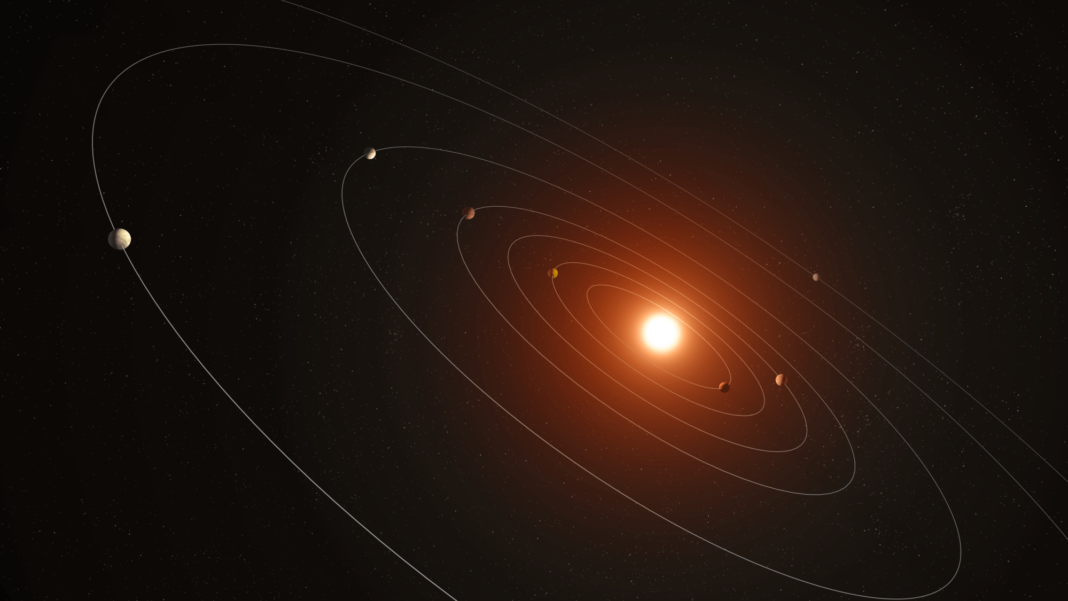Title: Unveiling the Mysteries of Our Solar System: Could an Alien Visitor Have Shaped Our Planets?
Billions of years ago, in the cosmic expanse of our solar system’s infancy, a remarkable event may have unfolded. Picture this: a colossal interstellar body, hundreds of times heavier than our Earth, making a fleeting appearance amidst the dance of our Sun’s planets. This isn’t the plot of a sci-fi blockbuster—it’s a hypothesis proposed by researchers Garett Brown, Hanno Rein, and Renu Malhotra that could shed light on the peculiar orbits of our planets.
The Story So Far:
Imagine a scenario where planetary paths aren’t the neat, circular trajectories we’ve always imagined. Instead, they are eccentric, tilted, and somewhat chaotic. For years, scientists have pondered over this cosmic puzzle. And now, a fascinating theory emerges—a visit from an alien entity, akin to the enigmatic interstellar object ‘Oumuamua, may have influenced these planetary motions through its gravitational pull.
As smaller cosmic wanderers like ‘Oumuamua zip through our solar neighborhood, this new hypothesis delves deeper. Brown and his team’s simulations suggest that a significantly larger object, ranging from 2 to 50 times the mass of Jupiter, could have left an indelible mark on our planetary system.
Exploring the Depths:
If this hypothetical visitor ventured close to our Sun, perhaps skirting near Mars’ orbit, it could have orchestrated a celestial symphony, rearranging the positions of our planets into their current enigmatic configurations. While most scenarios predict a relatively stable inner planet system, there exists a tantalizing possibility of planetary ejections or even a cataclysmic collapse of our solar system in rare instances.
Conclusion:
In the grand tapestry of the cosmos, encounters with alien entities like rogue planets or star clusters aren’t mere flights of fancy. Although the likelihood of such an event reshaping our solar system in the foreseeable future is slim, this theory serves as a poignant reminder of our limited understanding of the cosmic forces that have sculpted our celestial abode.
Frequently Asked Questions:
1. Could an alien visitor really have affected our solar system’s planetary orbits?
Yes, the hypothesis posits that a colossal interstellar object could have influenced the orbits of our planets.
2. What evidence supports this theory?
The researchers conducted simulations that suggest a massive object could have altered our solar system’s dynamics.
3. Are encounters with alien entities common in our galaxy?
The galaxy hosts numerous rogue planets and star clusters, increasing the likelihood of such encounters.
4. What are the potential consequences of such an encounter?
Theoretically, it could lead to planetary ejections or even a collapse of our solar system.
5. How likely is it for our solar system to interact with alien visitors?
The chances are slim, estimated to be between 1 in 1,000 and 1 in 10,000.
6. What makes the ‘Oumuamua comet significant in this context?
It serves as a reference point for understanding the potential impact of interstellar objects on our solar system.
7. Could our understanding of planetary orbits change based on this hypothesis?
Absolutely, this theory challenges conventional notions of planetary dynamics and offers fresh perspectives on our solar system’s evolution.
8. Is there ongoing research to validate this hypothesis?
Researchers continue to explore this intriguing concept through further simulations and astronomical observations.
9. How does this theory contribute to our knowledge of the solar system’s history?
It underscores the mysteries that shroud our solar system’s past, prompting us to reconsider the forces that have shaped it.
10. What implications does this hypothesis have for future astronomical studies?
It inspires a deeper exploration of cosmic phenomena and the potential interactions between our solar system and interstellar visitors.
Tags: Solar System, Alien Visitor, Planetary Orbits, Interstellar Object, ‘Oumuamua, Cosmic Forces

